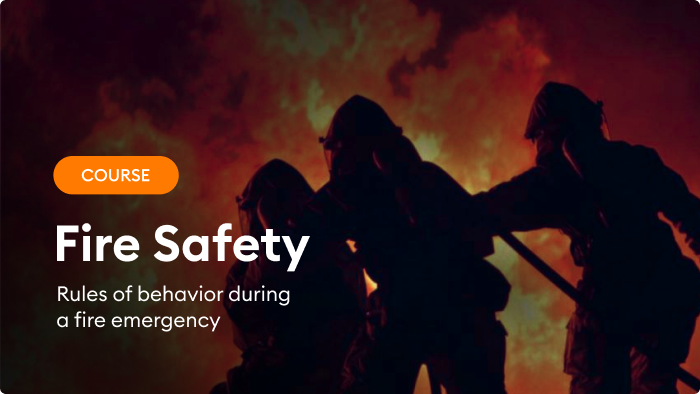What Is WHS and How To Organize WHS Training in Australia

WHS stands for Work Health and Safety, and it’s hard to overestimate the importance of the matter. In Australia alone, hundreds of workers die each year from work-related accidents. In 2019, 183 people died from work-related injuries, which is approximately one work-related death every two days. The high number of workplace injuries, accidents, and fatalities is a stark reminder of the importance of work health and safety (WHS) training.
This article guides you through the nuts and bolts of WHS. We’ll discover what WHS is, why it’s important, and how WHS training can prevent accidents and improve the overall working environment. Let’s dive in.
What Is WHS?
The Work Health and Safety (WHS) Act is a set of laws in the Commonwealth of Australia to promote better health and safety in the workplace. WHS comprises a broad range of codes of practices, policies, standards, and regulations that all businesses in Australia must adhere to. They are aimed at reducing the number of hazards in the workplace and preventing or mitigating work-related injuries, accidents, illnesses, and fatalities.
WHS applies to a wide range of worker profiles:
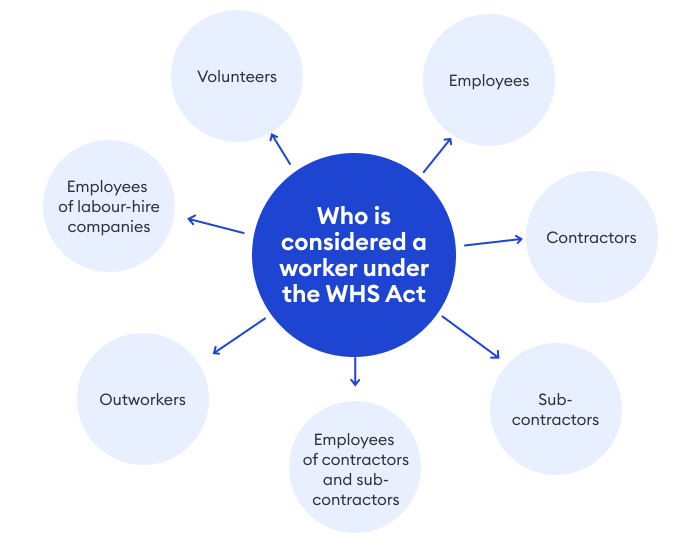
Until recently, WHS laws were referred to as Occupational Health and Safety (OHS) laws. This changed in 2012 when state and territory governments agreed to create model laws, known as the WHS Act and regulations. WHS laws were formulated with the idea that they could be used as a foundation for each state and territory to base their health and safety laws upon, leading to greater consistency in WHS across Australia.
In the infographic below, we have highlighted the 3 main objectives of WHS:
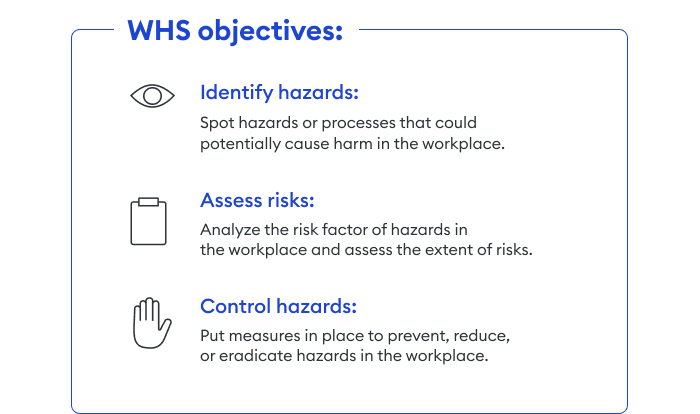
It is the responsibility of employers across Australia to communicate potential hazards to workers and to control them.
What Is the Difference Between WHS, OHS, and HSE?
First, let’s look at the difference between OHS (occupational health standards) and WHS (workplace health and safety).
After the law change surrounding workplace health and safety in 2012, the term OHS was replaced by WHS. While OHS laws varied from state to state in Australia, WHS is an Australia-wide policy that provides uniform guidelines for employers and workers across the country.
HSE (Health and Safety Executive), on the other hand, refers to the department or policy that supervises the health and safety of staff in the workplace.
WHS Legislation Requirements in Australia
In Australia, employers are legally required to manage workplace health and safety. WHS legislation works on a harm minimization model, making it the responsibility of every employer to identify workplace risks and implement appropriate measures to remove those risks.
In the table below, you’ll find an overview of the WHS laws:
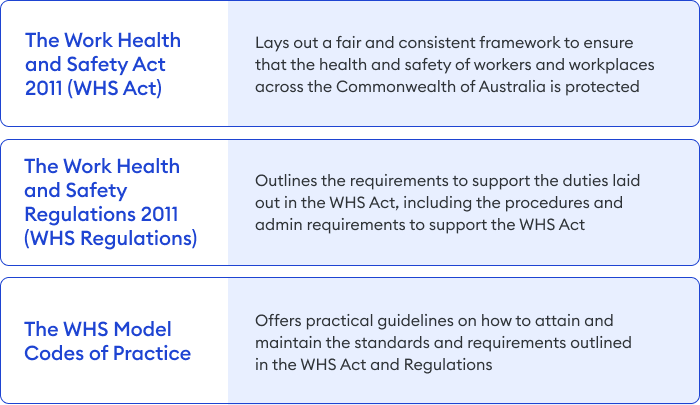
WHS is designed, managed, and enforced by several different stakeholders in Australia, including Safe Work Australia, COMCARE, the PCBU (“person who conducts a business or undertaking”), and the Standards Association of Australia (Standards Australia).
The Importance of WHS and Benefits for Business
Now that you know what WHS is, the next question to address is “Why is WHS important”? In this section, we explore the benefits of health and safety for the business.
1. Protect the safety and well-being of workers
Employers have a moral obligation to protect everyone in the organization. WHS gives all parties in the enterprise the tools they need to ensure they are safe, lower the risk of accident or injury, and reduce the number of hazards in the workplace.
2. Make the workplace more productive
Research has shown that workplaces that commit to protecting the safety and well-being of workers are more productive and efficient. WHS training promotes the prevention of workplace accidents and injuries. This reduces absences and distractions, maximizing everyone’s time at work.
3. Boost workplace morale
Creating a safer, better place to work reduces stress levels and empowers workers to feel safe and comfortable in their place of work. When workers know their employer cares and wants to protect their safety, they feel happier and more valued.
4. Lower costs related to accidents, injury, or compensation claims
Workplace accidents and injuries cost money. Employers will often have to cover expenses related to healthcare, rehab costs, losses due to absences and reduced productivity, and workers’ compensation payments. By reducing the number of workplace accidents and injuries, your business can save money and enjoy lower insurance premiums.
5. Build brand reputation and give your business a competitive advantage
A clean health and safety record promotes trust in your brand. Investors and potential partners often oblige companies to provide evidence of their commitment to corporate social responsibility, sustainability, and company culture. They pay close attention to your efforts to protect workers.
But it’s not just investors and partners who care about WHS. Customers are becoming increasingly interested in the ethics and values behind the brands they’re buying from. So, work practices like WHS can be an argument for choosing your brand.
Simply put, WHS protects everyone in the organization from work-related injuries or accidents. This creates a happier, more productive work environment, while enhancing the bottom line.
Who Is Responsible for WHS in the Workplace?
For many employers, WHS can seem confusing and even overwhelming at times. Part of this confusion is due to the uncertainty surrounding who the responsibility lies with. The short answer to this question is that the responsibility of compliance with workplace health and safety regulations falls upon both employers and employees. However, employers have specific legal responsibilities to implement and communicate WHS procedures and best practices in the workplace.
For the sake of clarity, we’ll break down a few of the specific obligations and responsibilities for both parties in the table below.
| Employers’ obligations | Workers’ obligations |
| Under WHS laws, it is the sole responsibility of the employer to facilitate a safe working environment. | Workers are accountable for upholding the WHS procedures, laws, and practices put in place by employers and for contributing to the overall safety of the workplace. |
|
|
Different Types of WHS Training
One of the most effective ways for employers to protect workers from WHS risks is by providing adequate WHS training. Some companies include WHS in other, more extensive training programs, while others create complete WHS courses. Let’s look at the most common types of training that include or focus on WHS.
Induction training
Induction training gives new workers all essential information about the company to help them settle into their new workplace. It offers an overview of the organization, its mission and values, outlines the company culture, the services and/or products it provides, and, of course, includes security training.
These are some of the most common WHS topics that are usually covered during induction training.
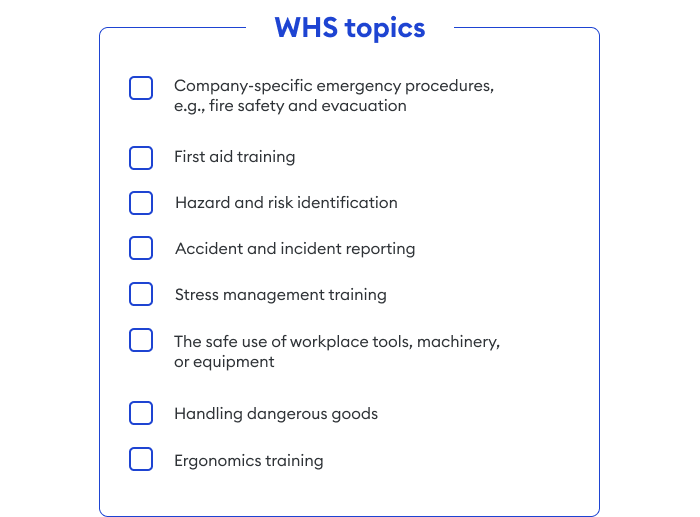
Refresher training
It’s important to refresh workers’ memories regularly when it comes to WHS best practices. Procedures can change and people can forget over time. So, employers should provide everyone in the organization with refresher training on key safety procedures to ensure that their knowledge is up to date.
Toolbox talks
As well as formal WHS training, such as an induction package, many companies use toolbox talks as an informal approach. Toolbox talks are casual meetings to communicate important information to workers. Just like induction training, this type usually covers a wide range of safety topics, such as:
- New equipment
- WHS updates
- Accident and incident updates
Toolbox talks can be performed in two formats:
- In person, such as during all-hands events, shift handovers, or planned huddles
- Online, as in virtual Q&A sessions
Specialized, industry-specific WHS training
Some industries are considered higher risk than others. In Australia, industries such as the construction and mining sectors must follow additional regulations and adhere to stricter WHS policies and standards.
Some examples of industry-specific WHS training courses are:
- Asbestos training
- Confined spaces training
- Working at heights training
Industries in Which WHS Is Vitally Important
According to the framework provided by the Australian Work Health and Safety Strategy, there are seven priority industries that have higher numbers of work-related injuries, accidents, and fatalities or are hazardous by nature. For these, WHS is vitally important:
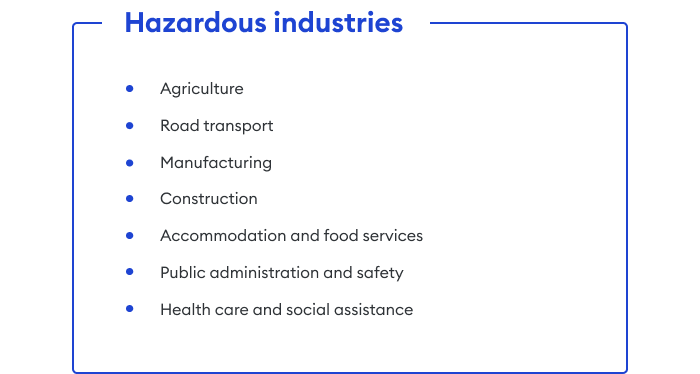
How to Organize WHS Training
In this section, we take a deep dive into the steps an employer should take to organize successful WHS training.
STEP #1. Conduct a needs assessment
The first step is to perform a needs assessment or training needs analysis. So, what’s the difference?
- A needs assessment helps you pinpoint if training on a specific topic is needed.
- A needs analysis digs a little deeper. It identifies the presence of a training need and tries to deduce the reasons for the gap and how to close it.
To conduct a thorough needs assessment, you should:
- Analyze the current situation. Identify the skills and knowledge that employees require to perform their job safely and then pinpoint gaps.
- Identify the business goal. For example, reduce workplace incident rates.
- Drill down to find the root cause of the problem. Start by reviewing the organization’s WHS history.
- Define the steps employees have to take to achieve the goal. Study the company risk assessments to see where information and training can help to control risks.
- Understand why they aren’t doing it. Research the reasons why workers aren’t currently taking the needed steps.
As WHS is such a crucial topic, there are several training priorities that you will need to factor into your needs assessment:
- Is there any specific training that the organization is obliged by law to provide?
- How will you provide this WHS training during working hours so workers don’t lose time or money? (This is why online WHS training is so valuable to employers.)
- Which knowledge gaps could result in serious harm and should therefore be addressed first?
- Does the training cover the needs of those changing to new roles, as well as new recruits?
Performing a needs assessment can seem like a daunting task, but it doesn’t have to be. Download this training needs analysis template for a quick guide to refer to when needed.
STEP #2. Choose your training methods
There are plenty of external WHS training options, such as safety courses by registered training organizations like PeopleSafe Australia or Safety Australia Group. The disadvantage of such ready-made courses is that they don’t take the specifics of your company into account. And they are often quite expensive.
However, you can readily create in-house training on your own. Developing in-house WHS training leaves space to customize it and make it relevant to workers. It can also be easily updated in line with organizational changes or changes to the law.
Let’s say you’ve opted for in-house training. What’s next?
Now it’s time to choose the format:
- In-person training
- Coaching or on-the-job training
- eLearning (online courses)
- Blended learning
- Group learning
- Individual learning
Many employers are turning to online WHS training for several reasons. Here are some of them:
It’s cost effective
Online courses reduce long-term costs related to training, such as travel, accommodations, and trainer expenses.
It’s flexible
In-person training should be carried out during working hours. This can be complicated in companies where shift work is prevalent. Online courses give employers and workers the flexibility to take them at the time that suits them the most.
It saves time
Many tasks related to training, such as sending reminders and managing enrollments, can be automated using eLearning tools, thus freeing up valuable time and resources.
It’s engaging and effective
Online training can create a truly compelling learning experience. Gamification, including aspects such as badges, point systems, and leaderboards, harness the power of game mechanics to bring dry topics to life, increasing retention and engagement.
It provides valuable data
Employers have to keep detailed records of WHS training in the event of a serious work-related accident or an audit. eLearning tools facilitate record-keeping, permitting employers to automate this process and remain WHS compliant. More on this in the FAQ section.
STEP #3. Create a training program
So, now that you’ve defined your organization’s training needs and the training format, it’s time to map out a training program.
1. Define training goals
Determine what the key expected learning outcomes are and come up with a maximum of three learning goals that you want your training program to achieve and three to five objectives per goal. Learning goals should be specific, measurable, actionable (use active verbs), realistic, and time-sensitive. For example: Reduce the number of workplace safety incidents by 5% by Q4.
2. Get to know your audience
Your training program needs to have a clear purpose and a target audience. Before you develop your training any further, get to know who your learners are going to be. Here are 5 essential questions you should ask yourself to get a good idea:
- How many learners will there be?
- Who are the learners? What positions do they hold in the organization?
- What is their learning profile? (What’s the average age? Are they reluctant to take employee training? What’s their preferred learning style? How tech-savvy are they? Where will they take the training? And so on.)
- Have the learners received previous training on the topic? What is their current knowledge level on the topic?
- What topics do they find relevant to their daily tasks?
3. Set learning objectives
While learning goals focus on business metrics, learning objectives focus on the learners. They outline what learners should be able to do or how they should feel after completing the training. Learning objectives are closely linked to the workers’ day-to-day activities, for example:
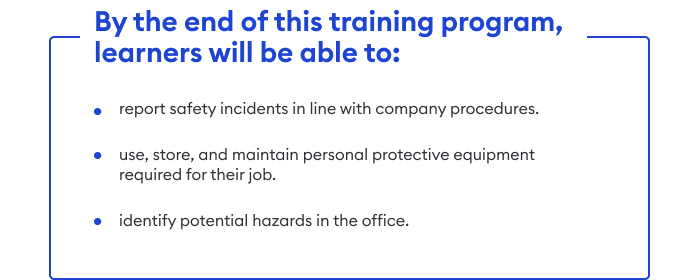
4. Identify Subject Matter Experts
Reach out to subject matter experts (SMEs) within the organization and consult external references and resources to get an expert opinion on your proposed training program. Thanks to their experience and expertise on the topic, SMEs can contribute invaluable content ideas, review the course content, and spot gaps in the content.
5. Outline the training plan
Now you need to decide how you’ll sequence the learning material so learners can absorb and retain it as well as possible. This will be the framework for your training program.
According to American educational theorist Charles Reigeluth, training content is best organized in increasing order of complexity so that each module or step in the learning program builds upon the previous one. This gives learners much needed context.
When coming up with the structure for a training program, keep these three key principles in mind:
- From context to content
- From general to specific
- From simple to complex
Once you’ve defined the structure of the training program and outlined the topics you plan to cover, it’s time to move to the next step: developing the training content.
STEP #4. Create learning content
If your organization would like to create in-house online courses with company-specific safety content, it will need a content authoring tool. This is the tool used to build courses with videos, text, images, interactive activities, and assessments.
Choosing a good all-round tool like iSpring Suite Max will offer you a lot of different options to create compelling safety training content.
iSpring Suite Max allows you to:
- Create courses in minutes with the simple PowerPoint format and a library of ready-to-use templates
- Develop training content for any scenario, such as spotting workplace hazards
- Engage learners with interactive activities such as dialogue simulations
- Build assessments to test learners’ knowledge and identify skill gaps
- Use video to explain complex safety topics simply
- Create multi-device learning content
- Easily update your learning content in line with organizational needs and changes to safety policies
This demo course on fire safety is a great example of what you can create with iSpring Suite Max:
STEP #5. Deliver the training
The next step is to deliver your online course. The most popular way to do this is with a Learning Management System (LMS).
An LMS houses all of your courses under one roof and allows you to manage and track all training through the platform.
It gives workers a simple, user-friendly process for completing courses. Everything is in one place and they can log into the LMS at a time that suits them to take training courses and review their results.
Opting for an intuitive LMS platform such as iSpring Learn LMS means learners can start their online training experience right away.
iSpring Learn LMS allows you to:
- Keep detailed training records by creating comprehensive, custom reports that offer proof of compliance
- Segment learners to offer personalized learning paths for employees who require different levels of safety training
- Harness the power of gamification tools such as badges, certificates, and points to motivate employees to take the training and give it their best effort
- Offer on-the-go learning via the mobile app so employees never fall behind on WHS training
- Automate training management tasks, such as managing deadlines and sending invitations and reminders
STEP #6. Measure training results
Once your online WHS training is live, it’s crucial to measure the results. By collecting training data, you can check the training is performing well, identify and plug safety knowledge gaps, and provide the necessary records to show that your organization is WHS compliant. By analyzing safety training data, you can take action before it’s too late.
LMS reporting allows employers to track a wide range of metrics and training results such as:
- Who has taken an online course
- How learners performed (assessment results)
- The time spent on the course
- Who hasn’t completed the course yet
Employers can use LMS reporting to check both individual and organizational training activity and flag learners who haven’t completed or who have scored low. This is not only essential for business record-keeping, but it also allows employers to keep track of WHS and make sure it is effective.
Want to know more? This handy article on LMS reporting will let you know how to utilize the analytics.
FAQ Section
We’ve put together a list of FAQs around WHS training to help workers and employers stay safe in the workplace.
#1 How important are WHS training records when proving compliance?
Safe Work Australia states that maintaining records of WHS training provided to workers is a core part of an effective training system. This is essential in the event of a serious workplace incident. If there is a court case, the business will need to provide WHS training records to prove its compliance with regulations and standards.
Records should include:
- What the training covered
- Who received it
- When it was taken
- How the training was conducted
It’s recommended that businesses keep electronic records of the course content and assessment records for the entire period that the employee is working for the business.
#2 How can employers ensure they are WHS compliant?
The best way is to provide plenty of high-quality WHS training and avoid “tick and flick” training. Organizations should also prioritize refresher training at least once a year to ensure that workers are up to date with all WHS rules, regulations, and measures and don’t become complacent.
#3 What are the potential consequences of poor WHS training?
Poor WHS training can lead to unsafe work practices that can result in work-related accidents, injuries, and even fatalities. Not only does this have a huge emotional and physical impact on everyone involved, but it can lead to financial implications as well.
Injured workers can lose wages because of workplace injuries and employers leave themselves open to fines, workers’ compensation payments, loss of productivity, and even imprisonment. In short, the consequences of not offering adequate WHS training are truly high for both employers and workers.
#4 What is the difference between a hazard and a risk?
According to Safework Australia, a hazard is “a situation or thing that has the potential to harm a person”, while a risk is described as “the possibility that harm – death, injury or illness – might occur when exposed to a hazard.” Put another way, a hazard is something that could cause harm, and a risk is how likely it is for harm to be caused.
Final Thoughts
WHS training gives everyone in the workplace the tools they need to stay safe and healthy at work. Moving WHS training online allows employers to save time and reduce training costs, as well as offering a more flexible training format and facilitating better record-keeping of training.
To start creating WHS learning courses, get a 14-day free trial of the iSpring Suite authoring toolkit and iSpring Learn LMS right away.
